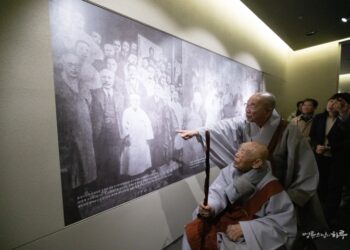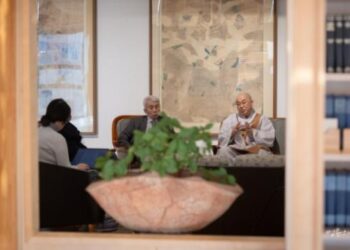Jun 28, 2025. – INEB Day 3, Visit to Bongamsa Temple, Discussion on Practice
Hello. Today is the third day of the INEB (International Network of Engaged Buddhists) study tour. Sunim traveled to Mungyeong with the INEB delegation, visiting Bongamsa Temple in the morning and spending the afternoon at Mungyeong Jungto Retreat Center discussing Jungto Society’s practice programs.
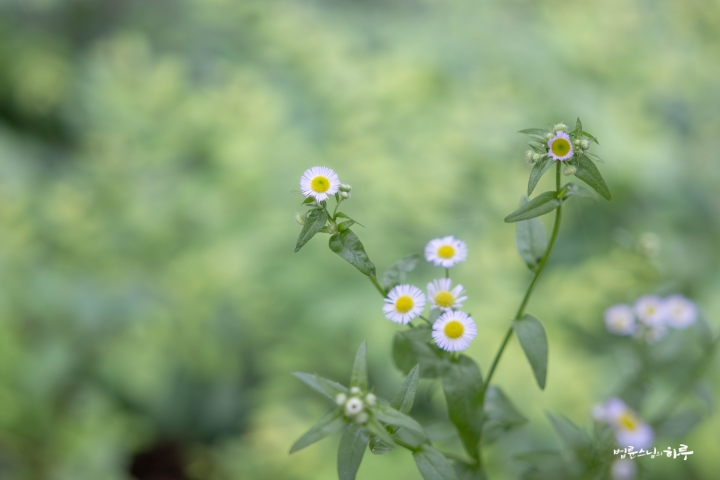
Early in the morning, after completing morning practice and Barugongyang at Seoul Jungto Social and Cultural Center, the INEB Jungto delegation departed Seoul at 7:20 AM heading for Mungyeong. Their destination was Bongamsa Temple, a central temple of Korean Seon Buddhism.

After a two-hour drive, they arrived at Bongamsa Temple at 9:20 AM. Abbot Wongeun warmly welcomed Sunim and the INEB delegation.
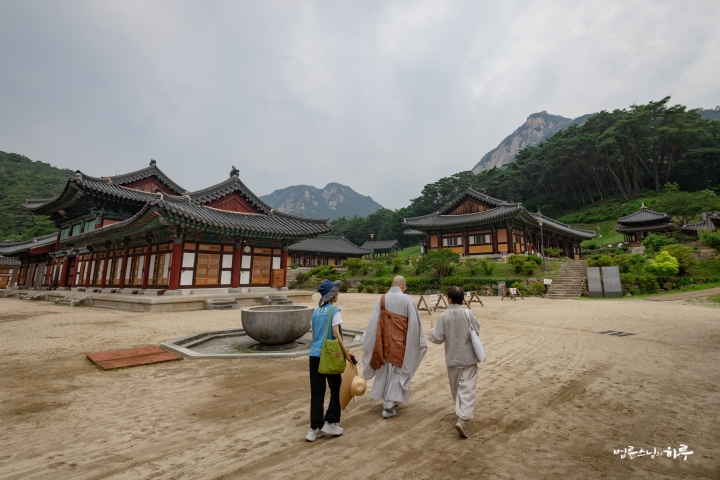
They enjoyed refreshments thoughtfully prepared by Bongamsa Temple while engaging in conversation. First, the abbot gave welcoming remarks.
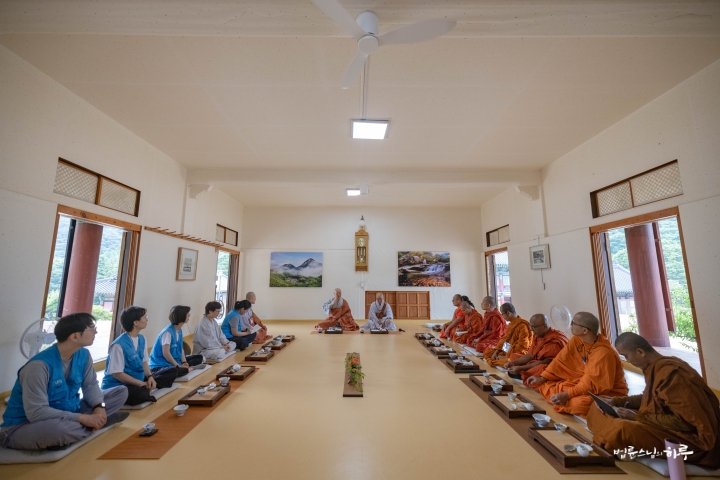
“I welcome the great practitioners from various countries who have visited our Bongamsa Temple. Bongamsa is a place for Ganhwaseon practice. Many monks conduct winter and summer retreats here, and there are retreats in between as well, so the meditation hall operates continuously. While this is a global phenomenon, Bongamsa also used to have 120 participants practicing meditation, but the number has gradually decreased to about 60 currently.”
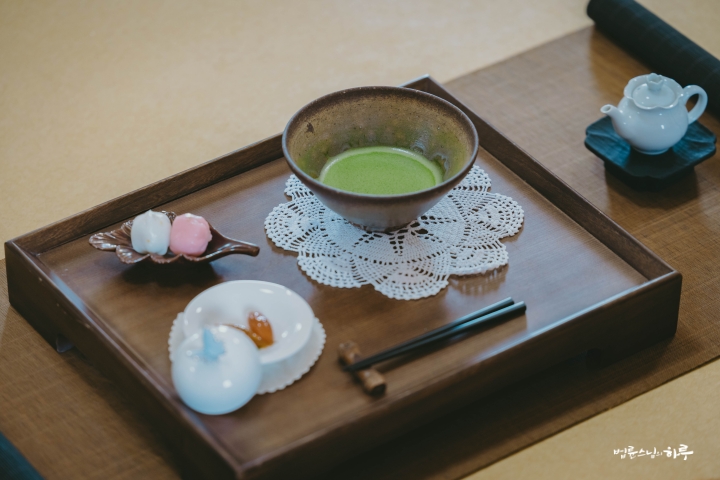
The INEB participant monks asked many questions about Ganhwaseon.
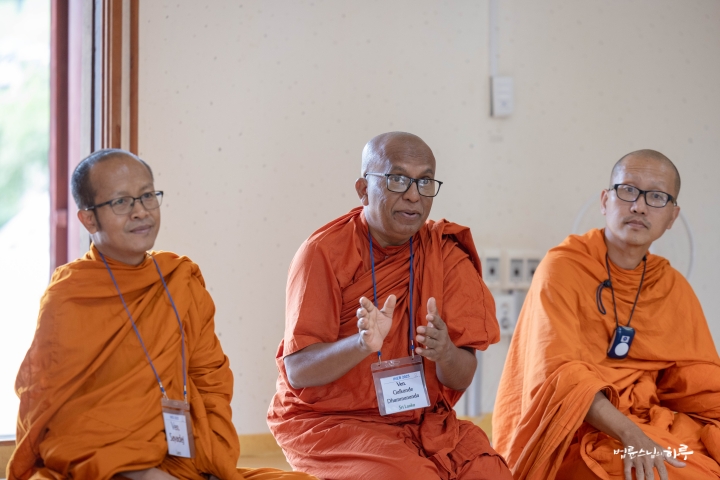
“You mentioned that when practicing Ganhwaseon, one holds a hwadu and questions oneself with a clear mind. In that case, do we focus on our mind? Should we also be aware of other elements of our mind?”
The abbot answered.
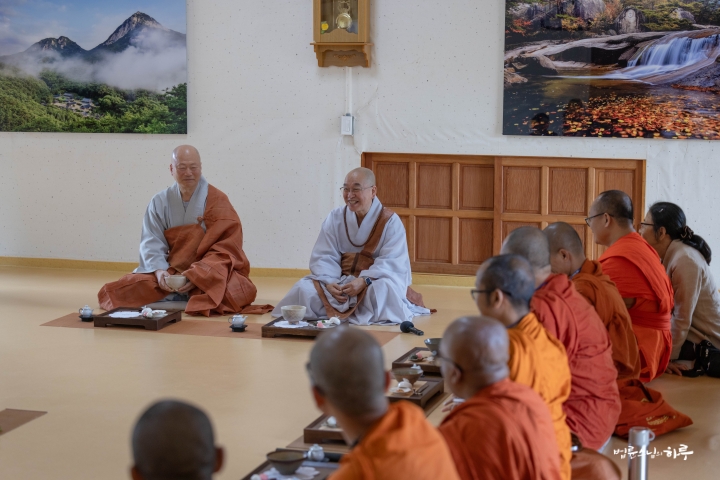
“The more you struggle to find the mind, the further it drifts away. What most hinders practice is the mind of possession. For Korean monks, pockets are a major obstacle to practice. Because our robes have pockets and we keep trying to put money in them, this prevents us from practicing. But if you wear only kasaya like those of you from the southern tradition, there’s no place to put money. I understand you still receive respect from lay people through alms rounds. I think this is a way of maintaining the Buddha’s fundamental teaching of non-possession.”
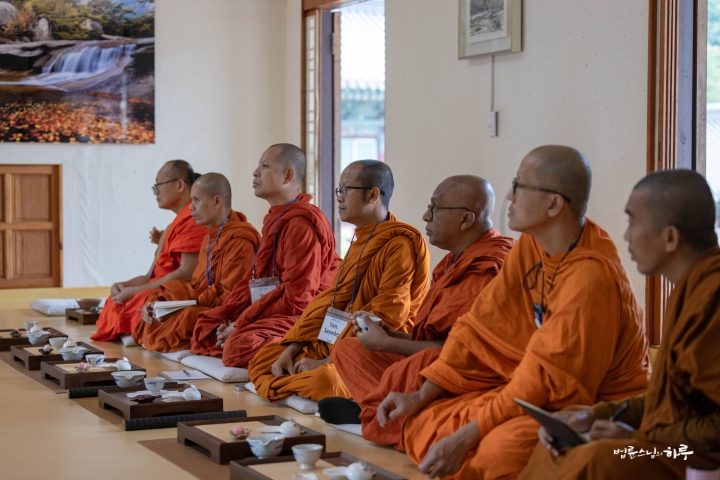
After hearing the abbot’s answer, Venerable Kongsin from Thailand said with a smile:
“We also have pockets inside our kasaya.” (Laughter)
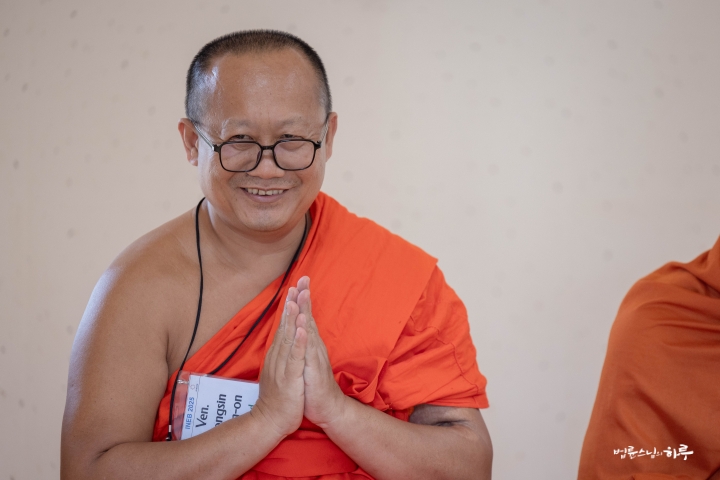
He then turned his red kasaya inside out to show how fabric was added to create a pocket. The room instantly filled with laughter.
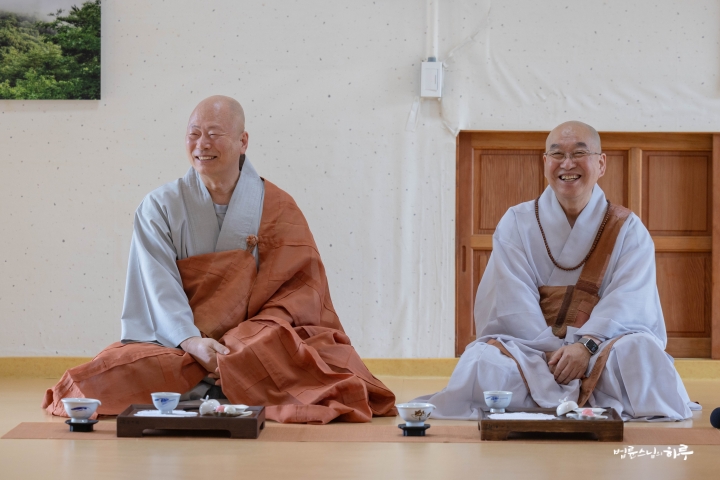
The abbot spoke about what true non-possession means.
“Living in the mountains doesn’t mean realizing non-possession. True non-possession comes when one can possess many things but remains indifferent to possession. Even if one has a lot of money, if that money is used to alleviate many people’s suffering, that is a life of non-possession.”
Before they knew it, the hour we had promised quickly passed. Sunim expressed gratitude to the abbot for making time in his busy schedule.
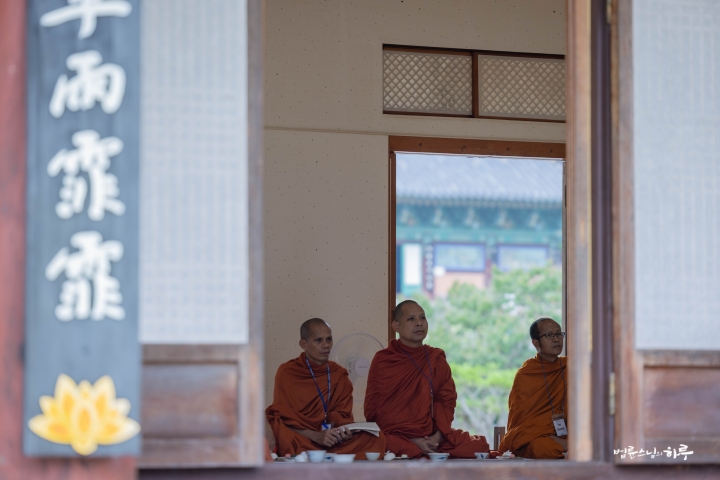
The INEB participant monks paid respects at the main hall. Then Sunim personally guided them through the temple grounds, sharing stories about the meditation hall and the practice sites of great masters.
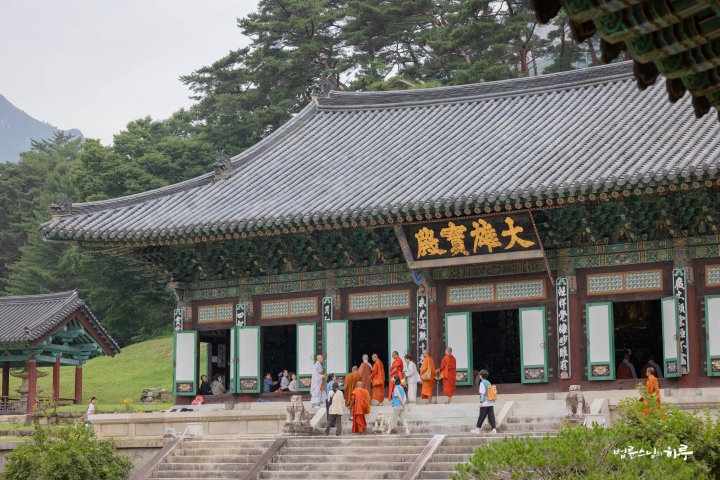
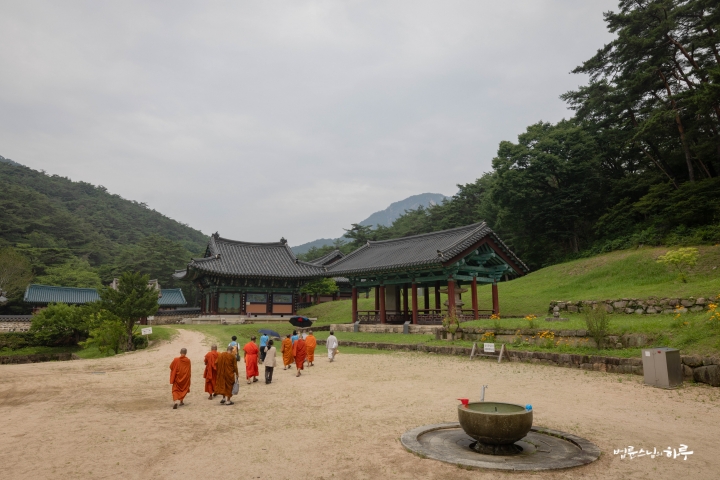
After viewing the stupa of Master Jijeung who founded Bongamsa, Sunim explained.
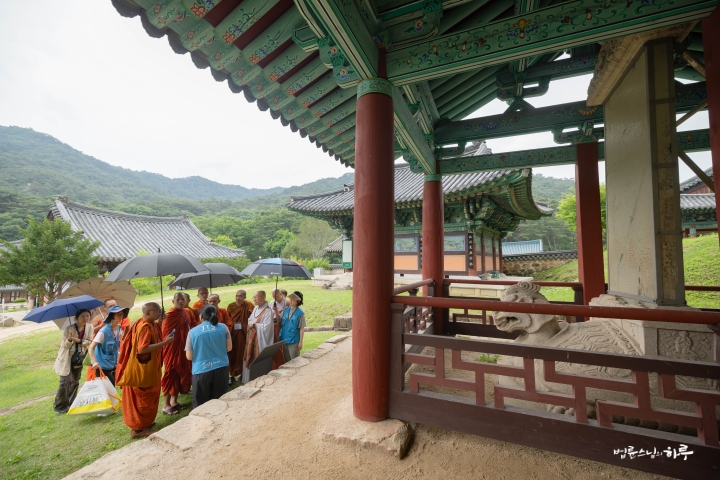
“Bongamsa is an ancient temple founded by National Master Jijeung about 1,100 years ago in the 9th century. However, most of it was destroyed during the Japanese invasion in the Imjin War. It has been restored to its current form in recent times.
In Korea, most temples have been destroyed through three major events. The first was the Mongol invasion in the 13th century. At that time, temples on the plains were destroyed, but most were restored. The second was the Japanese invasion in the 15th century. At that time, most temples in the mountains burned down. This was because monks organized monk armies to resist the Japanese invasion. Since it was during the Joseon Dynasty which suppressed Buddhism, proper restoration couldn’t be done afterward. Without support from the state and people, monks independently restored the temples. The third was during the Korean War when many were destroyed by bombing. Especially temples in North Korea were mostly lost. Because guerrilla fighters resisting in the mountains were pursued, temples were destroyed in the process. Temples in South Korea have been largely restored, but many sites still remain empty.”
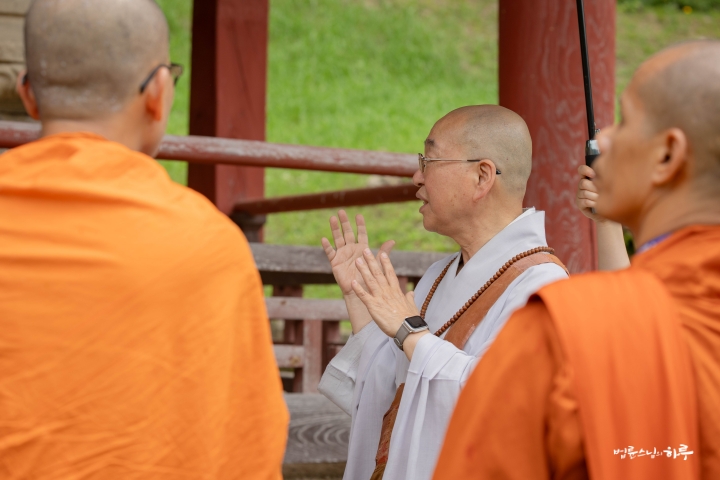
Next, Sunim visited the Josajeon Hall, which enshrines the successive patriarchs who rebuilt Bongamsa Temple. Standing before the portrait of Great Master Seoam, Sunim continued his explanation.
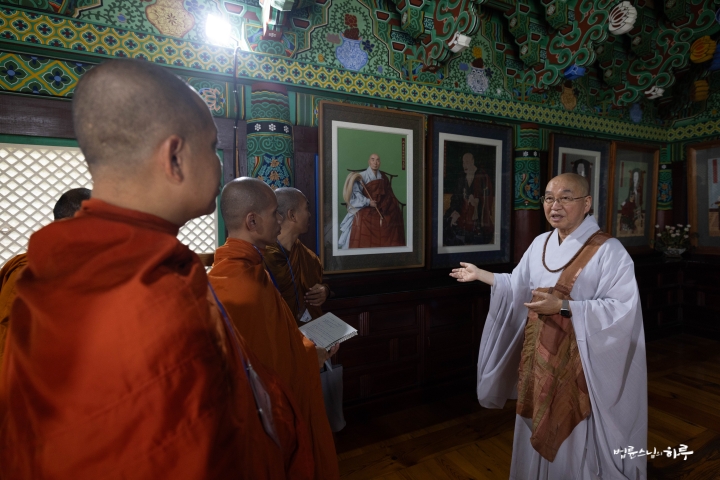
“This is my teacher, Great Master Seoam. My ordination master who gave me the precepts was Great Master Bulsim Domun, and this person taught me meditation. He restored Bongamsa Temple from ruins to its current state. Being a Seon master, he didn’t engage in administration, but when the order faced difficulties, he briefly served as the President of the Jogye Order, served as Chairman of the Council of Elders, and also served as Supreme Patriarch.”
After viewing the three-story stone pagoda, Sunim headed toward the Main Buddha Hall.

After taking a commemorative photo in front of the Main Buddha Hall, everyone moved to the dining hall for lunch together.
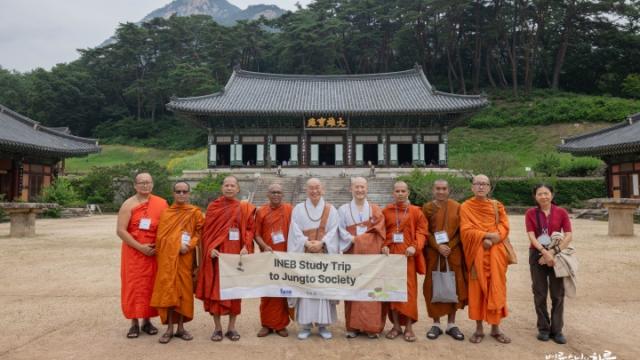
Bongamsa Temple had carefully prepared bibimbap. After offering a prayer of gratitude in the Theravada tradition, everyone had their meal.
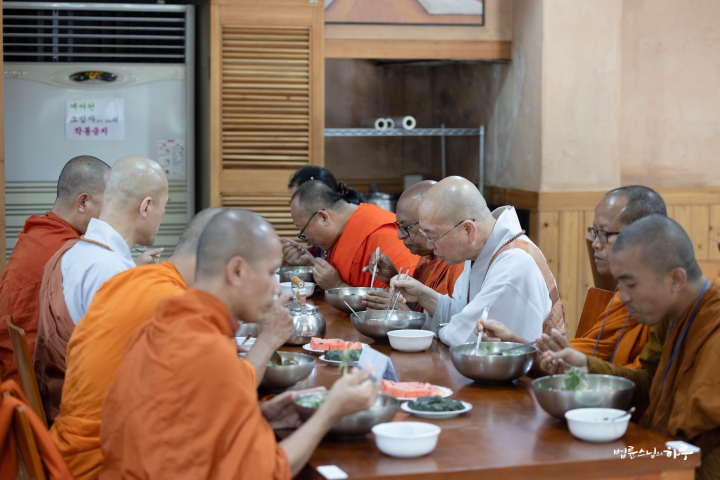
After finishing the meal, Sunim made a suggestion.
“Let’s take a short walk here before heading to Jungto Retreat Center.”
Walking up the winding mountain path, they arrived at Great Master Seoam’s stupa.
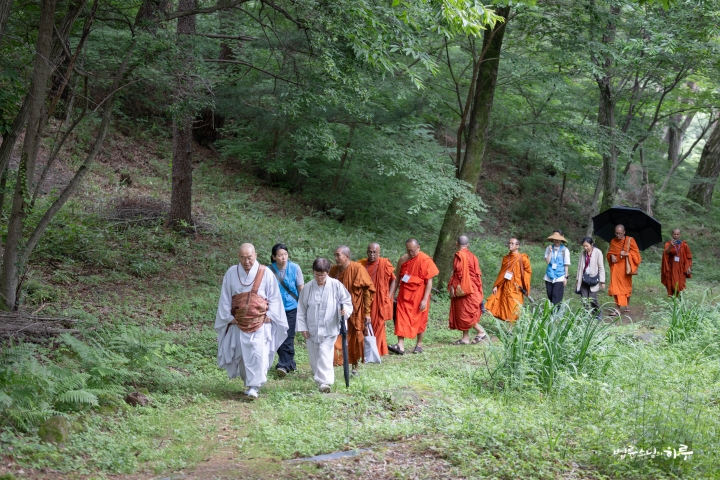
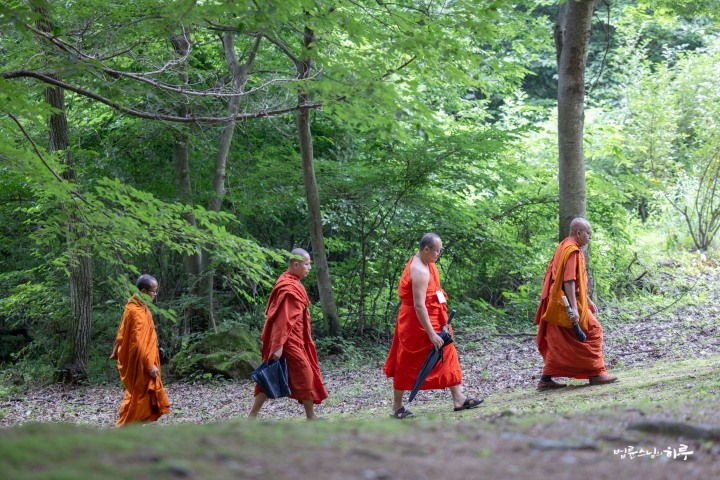
Standing before Great Master Seoam’s stupa, they offered three prostrations.

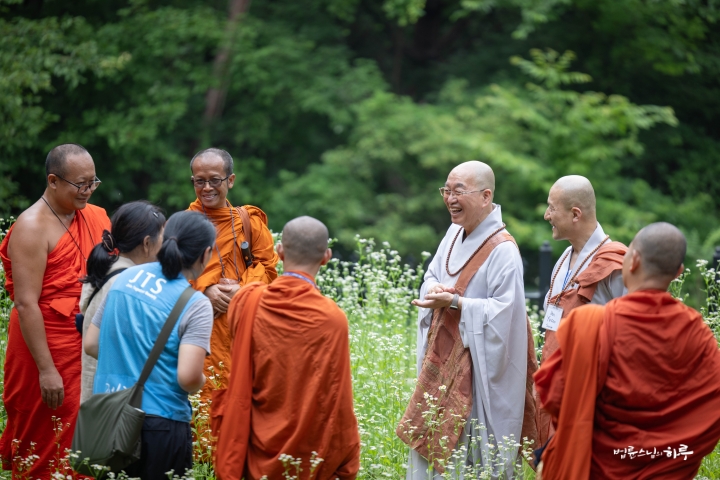
The INEB delegation visiting Jungto Society then moved to Mungyeong Jungto Retreat Center. After a brief preparation time, presentations and discussions began at 1:30 PM in Jeongnyeomdang Hall. Today’s topic for presentation and discussion was ‘Practice.’
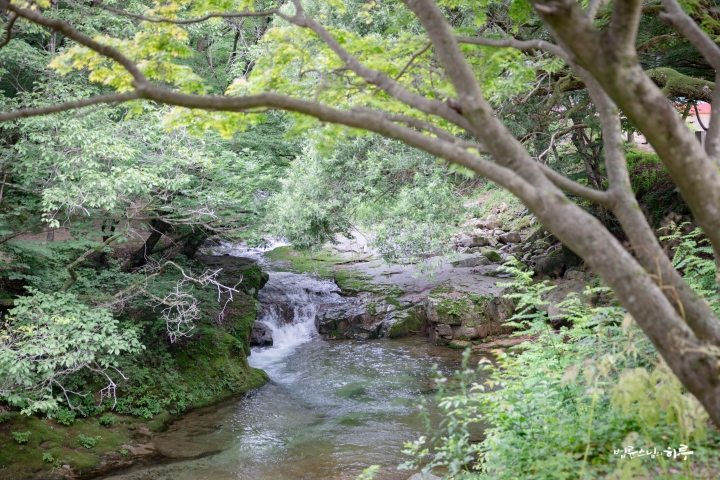
First, Jungto Society volunteer Choi Ji-seon explained Jungto Society’s practice programs along with the historical flow of Korean Buddhism. She traced from the introduction of Buddhism during the Three Kingdoms period, the Nine Mountain Schools of Seon and Wonhyo’s popular Buddhism movement during Unified Silla, the decline due to the policy of suppressing Buddhism and promoting Confucianism during the Joseon Dynasty, the introduction of married monks during Japanese colonial rule, to the Buddhist reform movement by Master Yongseong in modern times, explaining how Jungto Society’s practice methods were formed within this historical context.
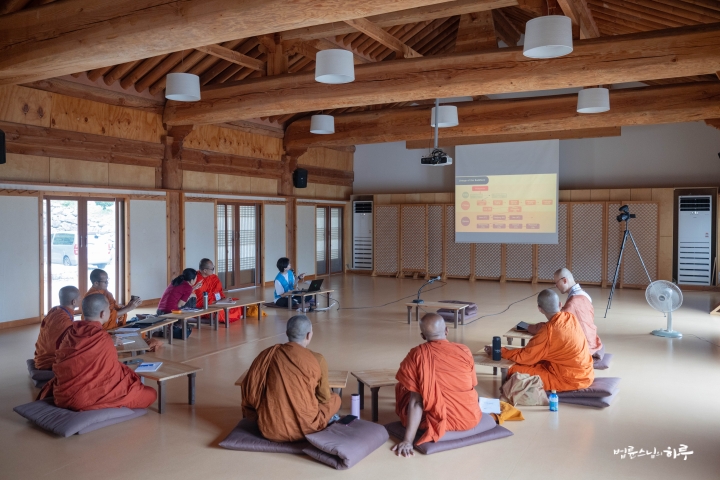
She then introduced in detail Jungto Society’s representative practice programs: the ‘Awakening Retreat’ and ‘Sharing Retreat,’ as well as the intensive meditation program ‘Meditation Retreat.’ She also explained that they operate a continuous and practical practice community through the 100-Day Chulga program and Haengja Institute.
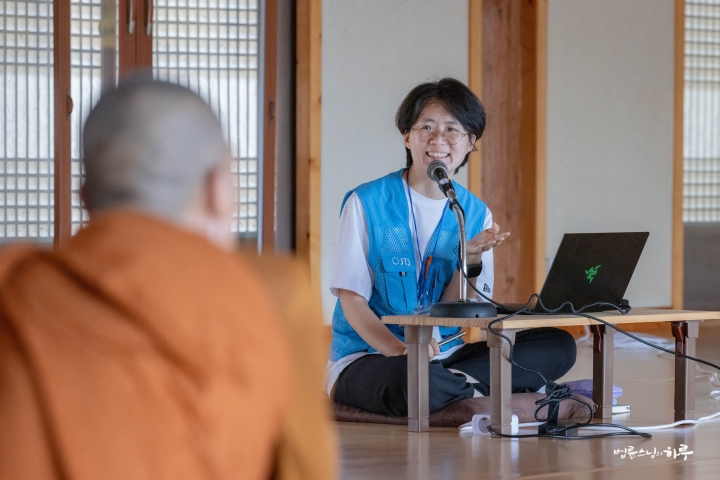
After the presentation, questions were taken. Various questions followed, such as “Why are people increasingly losing faith in Buddhism?”, “What was the purpose of spreading married monks during Japanese colonial rule?”, and “Can foreign nationals participate in the practice programs?”
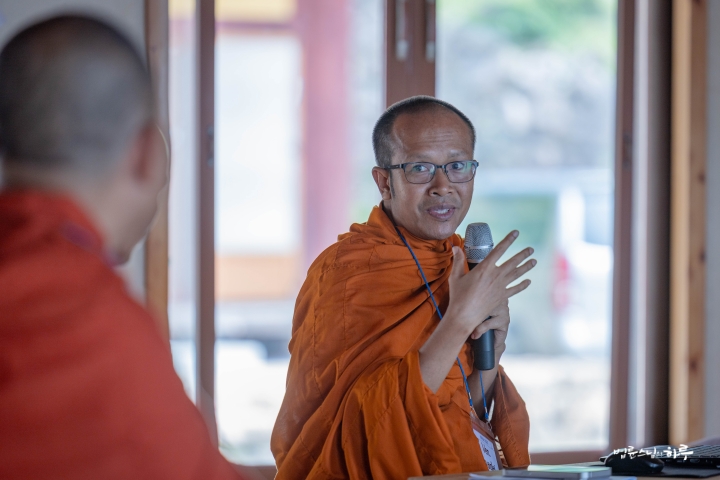
After the Q&A session and a short break, there was time to hear presentations from the INEB participant monks. Ven. Pok Pan, Vice President of Preah Sihanouk Raja Buddhist University – Battambang Branch in Cambodia, introduced his university.
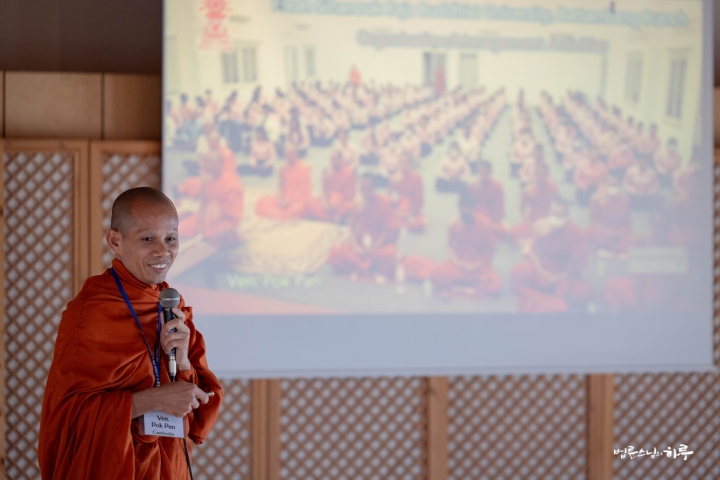
“Our university was established in 2008 and currently has 1,756 undergraduate students and 134 graduate students, including about 180 monastics. The undergraduate programs consist of various fields including Khmer Literature, Educational Administration, General Management, English Literature, Law, and Philosophy, while graduate programs continue in Educational Administration, Public Administration, Law, Philosophy, and Literature. The university’s vision centers on ‘Education,’ ‘Social Engagement,’ and ‘Peace’ as core values, and we practice the four immeasurables – loving-kindness, compassion, sympathetic joy, and equanimity – as the foundation of our education.”
Everyone gave applause of empathy and encouragement when he mentioned maintaining the university through solidarity and practice despite operational difficulties such as insufficient funding, infrastructure, and low wages.
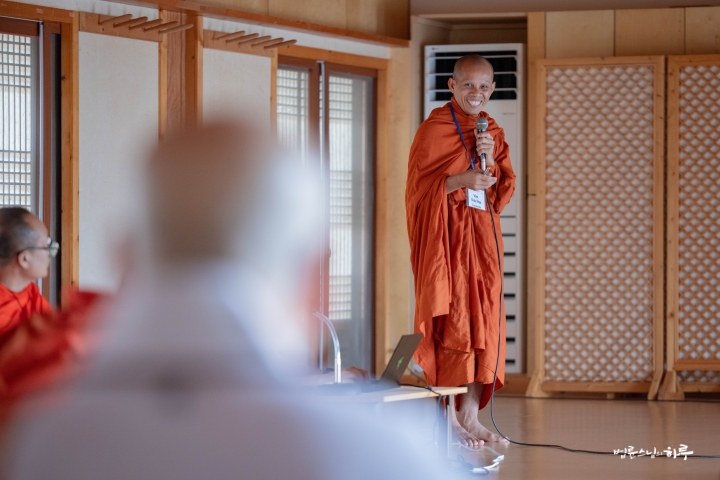
After the presentation and a short break, a Q&A session with Venerable Pomnyun Sunim continued from 3 PM.
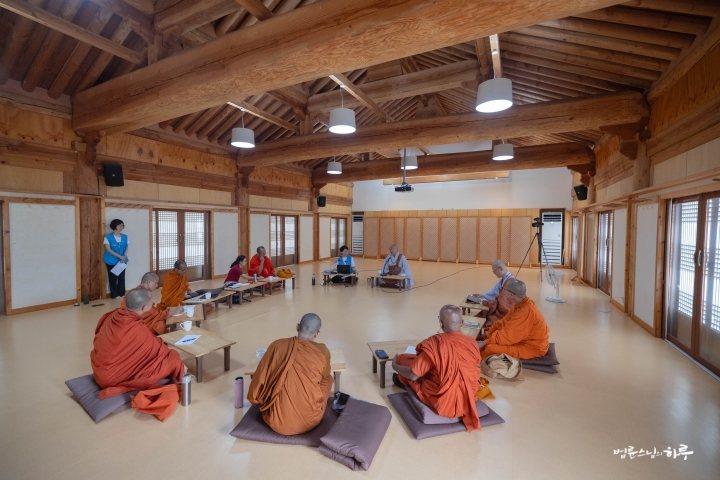
Ven. Dhammananda from Sri Lanka requested a detailed explanation of what content Jungto Society’s practice programs cover. Sunim responded.
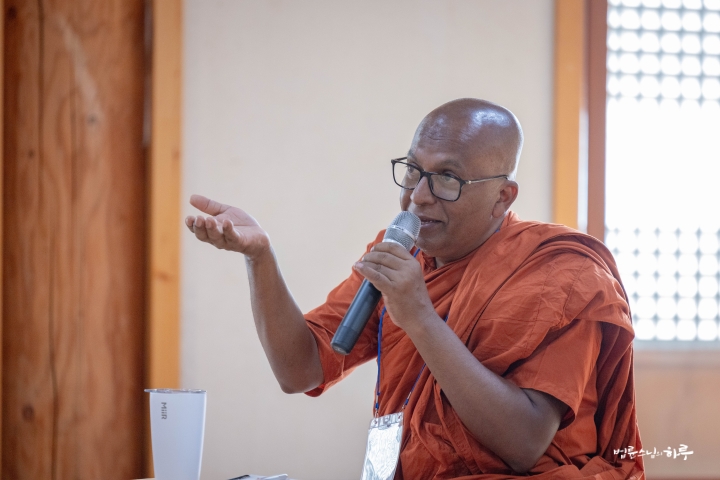
What Practice Programs Does Jungto Society Conduct?
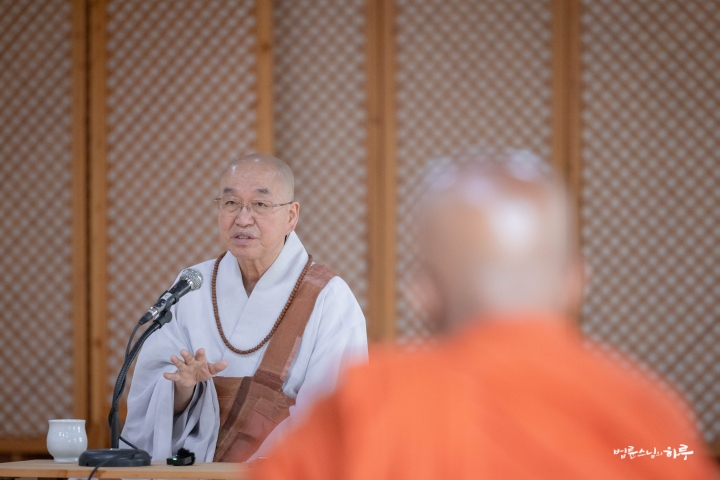
“To become a member of Jungto Society, one must first change their perspective on Buddhism. Buddhism can be divided into three approaches: Buddhism as a religion centered on faith, Buddhism as philosophy centered on knowledge, and Buddhism as practice centered on experience. Jungto Society pursues Buddhism centered on the practice of attaining enlightenment. Most people approach Buddhism not as practice for enlightenment but lean toward philosophy focused on learning knowledge. However, knowing a lot about Buddhism intellectually actually becomes an obstacle to enlightenment. This is because instead of exploring questions for themselves, people try to find answers through their existing knowledge. Such preconceptions are false beliefs. In other words, they can be called ‘ignorance.’ Preconceptions are the greatest obstacle to wisdom. If you keep trying to find answers through thinking, it’s difficult to experience wisdom. That’s why people without religion have at least no false beliefs, which can actually be advantageous for enlightenment. When conducting the ‘Awakening Retreat,’ we find that people who have believed in Buddhism for a long time have more difficulty attaining enlightenment than those without religion.
The ‘Awakening Retreat’ is a program based on the Seon Buddhist tradition, adapted to be more closely connected to daily life. The ‘Sharing Retreat’ is similar to the Vipassana practice method of the Theravada tradition. The ‘Awakening Retreat’ focuses on breaking down fixed ideas, while the ‘Sharing Retreat’ focuses on becoming aware of states arising in one’s mind. Seon Buddhism explores the ‘hwadu’ – before words emerge, that is, before thoughts arise. Hwadu means ‘the head of words,’ meaning before words emerge. Before words emerge means before thoughts arise. This focus on the stage before thoughts arise is similar to Vipassana’s focus on awareness of feelings and sensations without thinking. No matter what sounds are heard outside or what sensations arise in the body, one only focuses on awareness of breath at the tip of the nose. In other words, when exploring hwadu, one must not think. Thinking is merely contemplation. However, most of us sit and keep thinking.
The ‘Awakening Retreat’ was developed from these principles of Seon Buddhism. There are two main things dealt with as hwadu in Seon. One is ‘mu (無)’ – continuously exploring ‘nothingness.’ The other is ‘What is this?’
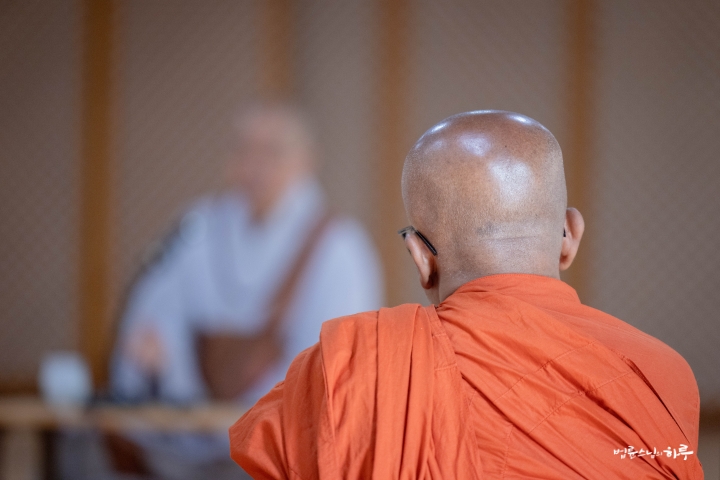
Among them, the hwadu of ‘Mu (無)’ began like this. A disciple was meditating when he kept hearing some sound from nearby. During meditation, even if there are sounds, one should not pay attention to them and focus solely on the hwadu. However, as the sound continued from the side, his mind was drawn to it. When he looked at where the sound was coming from, he saw a dog picking up and spitting out a bone with no flesh on it. No matter how much the dog gnawed on the bone, there was no flesh, so there was no benefit. In short, the dog was doing something pointless. At that moment, a question arose. The Nirvana Sutra, a Mahayana Buddhist scripture, states that the Buddha said, ‘All living beings have Buddha-nature, the potential to become a Buddha.’ This means that even the dog gnawing on the bone has Buddha-nature. However, looking at what the dog was doing, it seemed utterly pointless. According to the scripture, this would mean that a Buddha was doing something pointless. When the disciple studied the scripture, he simply believed that all living beings have Buddha-nature. But seeing the dog’s specific behavior, he questioned whether it could really be said to have Buddha-nature. So he went to his master and asked, ‘Does that dog also have Buddha-nature?’ The master replied, ‘Mu.’ Hearing this, the disciple’s heart became completely blocked. It’s also described as becoming blind and deaf. Why did this happen?
We might think about it this way. First, one could ask, ‘The scripture says all living beings have Buddha-nature, so why does the master say it doesn’t?’ However, this is an attitude of not trusting the master’s words. In Seon Buddhism, it is said that one cannot attain enlightenment without trusting the master’s words. Second, one might think the master is right and wonder, ‘Is the scripture wrong?’ In this case, it means not trusting the Buddha. But how can one attain enlightenment without trusting the Buddha? Third, one could investigate which is correct between the Buddha’s words and the master’s words. This means not trusting either of them. But what phenomenon occurs if one trusts both the Buddha and the master? If one believes both the scripture’s words and the master’s words, then ‘Mu’ is no longer the concept of ‘nothing’ as in ‘exists’ or ‘doesn’t exist.’ One begins to explore what the master meant by saying ‘Mu.’ At this point, all thoughts come to a complete stop. Any knowledge one had until now becomes unnecessary. One must explore solely on their own. This is the attitude of constantly investigating the ‘hwadu’ whether awake or asleep. When one genuinely becomes curious about something on their own, it becomes a true hwadu.
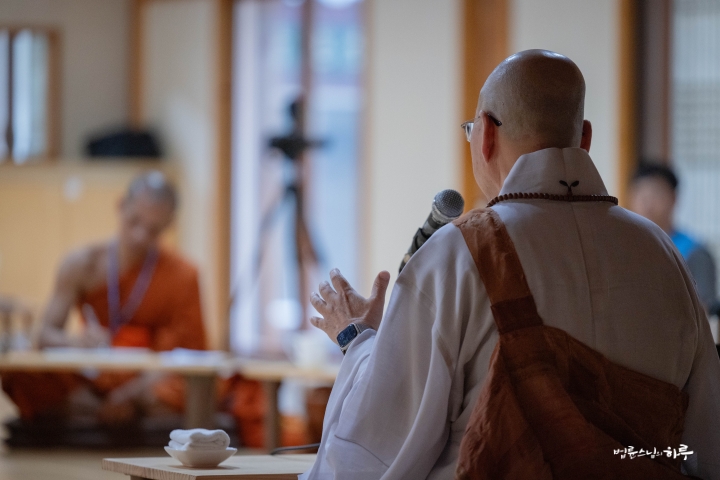
Jungto Society offers three educational programs: Happiness School, Jungto Dharma School, and Sutra Course. For practice, there are three programs: the Awakening Retreat, Sharing Retreat, and Meditation Retreat. In the future, we plan to add the Buddhist Social Studies Course, which explores how to view world issues. If you want to experience practice at Jungto Society, you can set aside about five days to try it. However, it’s not easy. The fact that I am a monk and know Buddhism doesn’t help at all.”
After hearing Sunim’s explanation, Venerable Kongsin from Thailand laughed and said:
“Then it seems I should first get rid of my religion before participating.” (Everyone laughed)
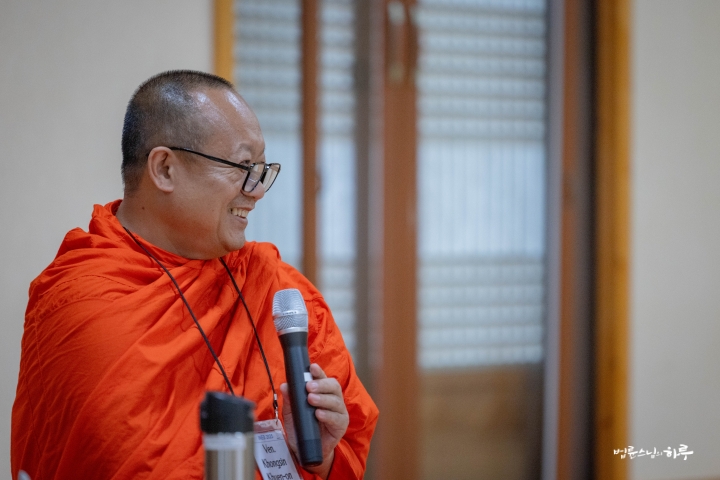
Questions continued one after another. After receiving various questions about practice and having discussions, it was time for dinner.
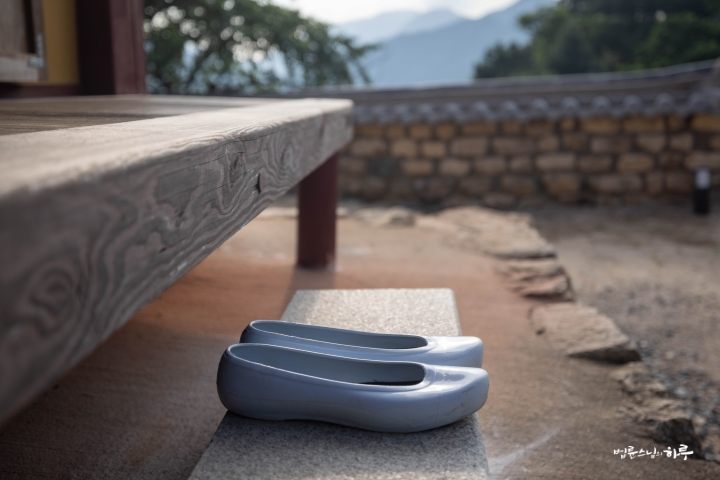
After a simple dinner of yogurt and juice, evening prayers were held in the Theravada tradition, led by Venerable Dhammananda from Sri Lanka.
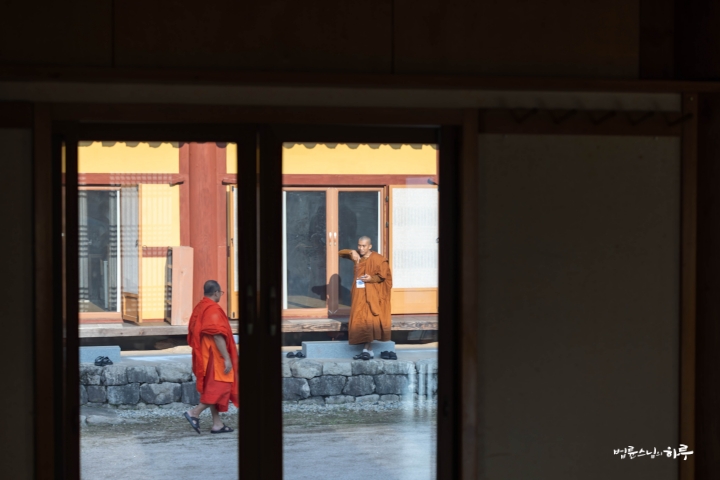
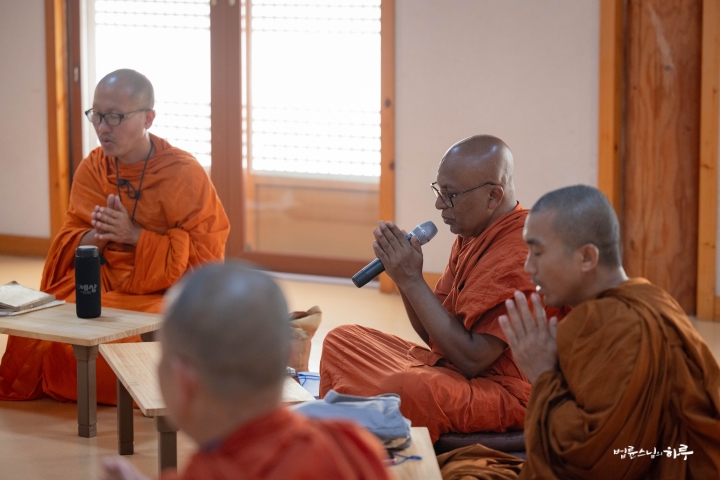
As the sun set, the intense heat subsided and a cool breeze began to blow.

From 7 PM, JTS introduced its sustainable development projects in Bhutan, followed by a video showing Sunim’s multiple survey trips to Bhutan.
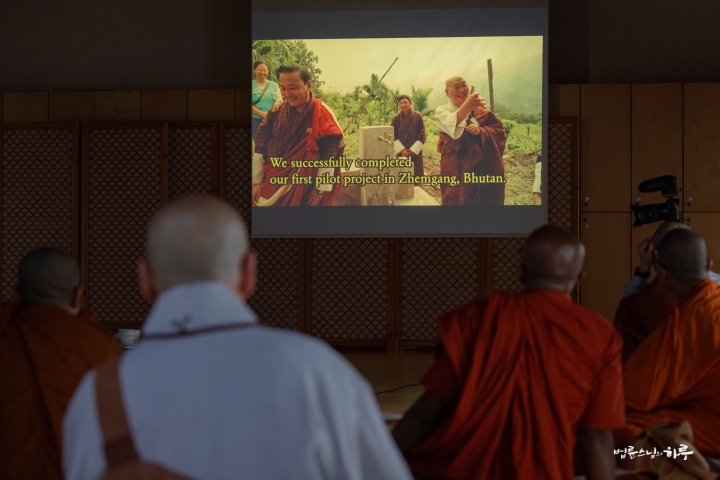
Everyone was deeply moved by Sunim’s dedicated activities and gave him applause.
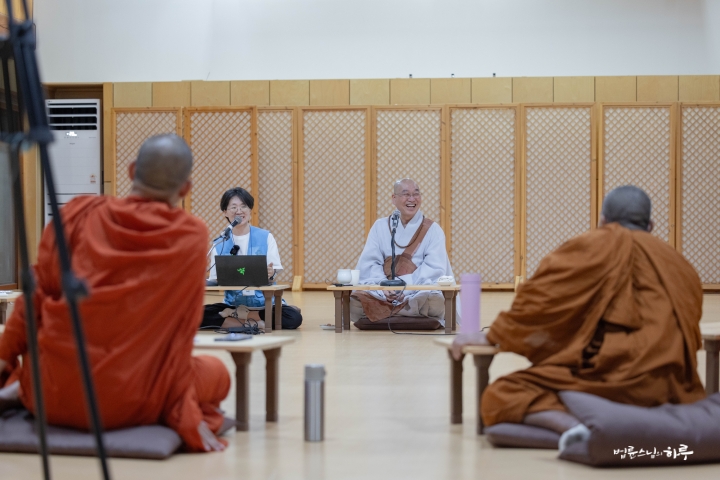
In the evening, there was time for free discussion. Venerable Kongsin from Thailand shared his concerns about the difficulties in educating children these days.
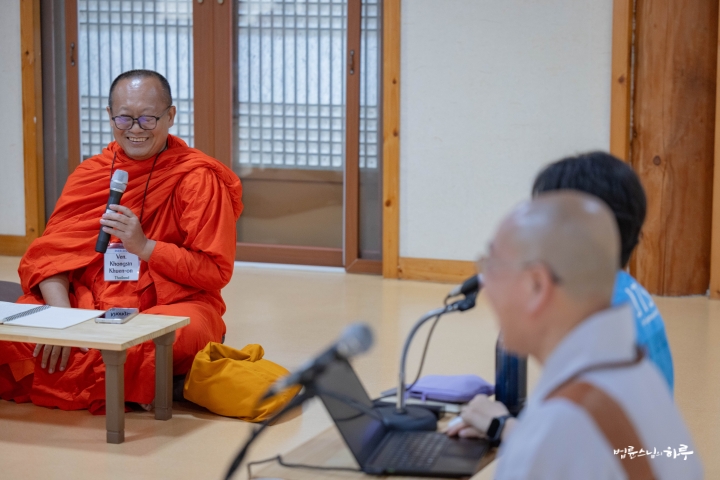
“When I was young, I studied hard because I was afraid of being hit by my teacher. But children these days are different. When we do walking meditation, they resist if we go just a little far, saying it’s too hard. How should I change my teaching methods? Would it help if I sent the children to stay at Jungto Society for a few days? It’s frustrating to see children absorbed in games and social media.”
Sunim emphasized that parents must change for children to change, and shared his experience of guiding youth in his younger days.
Next, Venerable Sovichia from Cambodia mentioned Sunim’s activities around the world, including Bhutan and Syria, and asked how he was able to build trust with people.
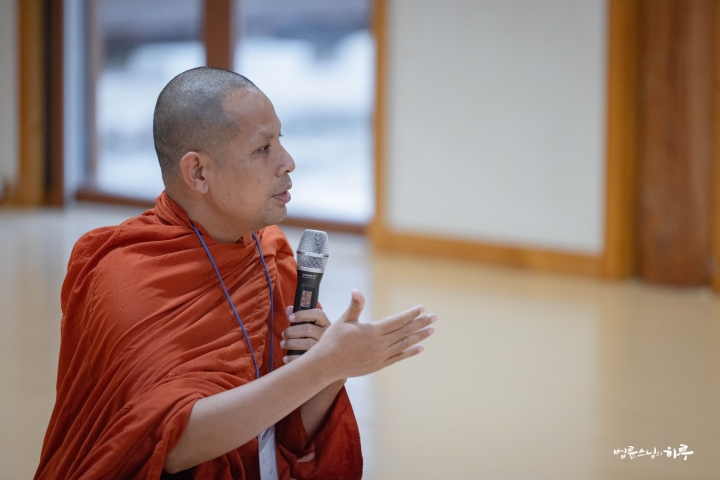
How Have You Built Trust with People to Win Their Hearts?
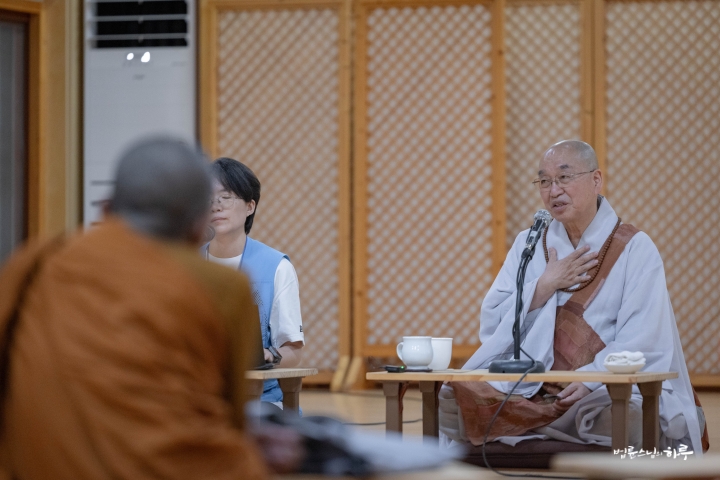
“Of course, finances are necessary to carry out activities that help others. However, if money comes first, it won’t last long. You need to have the perspective of working together with people.
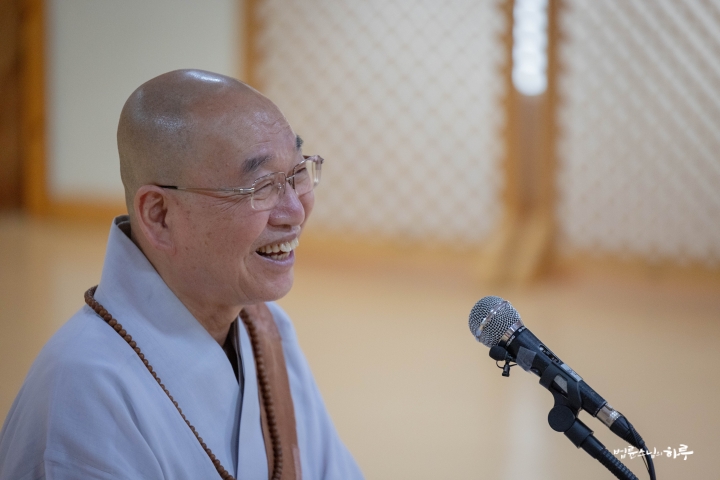
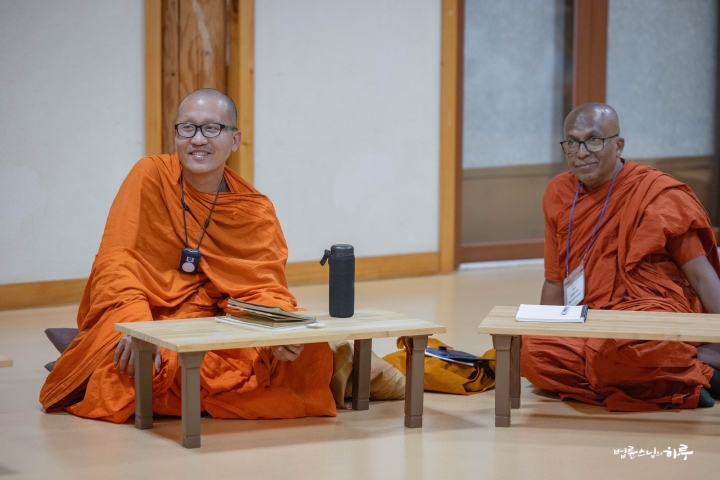
Trust is not built from the beginning; it takes a lot of time. JTS has been conducting relief activities in the Philippines for 20 years, and as trust has gradually built up, villagers and local governments have come to request that we build schools. When they ask for help, it becomes very easy for JTS to explain our principles. Conversely, when JTS offers to do something, we must do it the way they want. However, JTS helps when residents say they will take the initiative to do what they want. So we always ask the residents:
‘Do you really need this? Can you do it yourselves?’
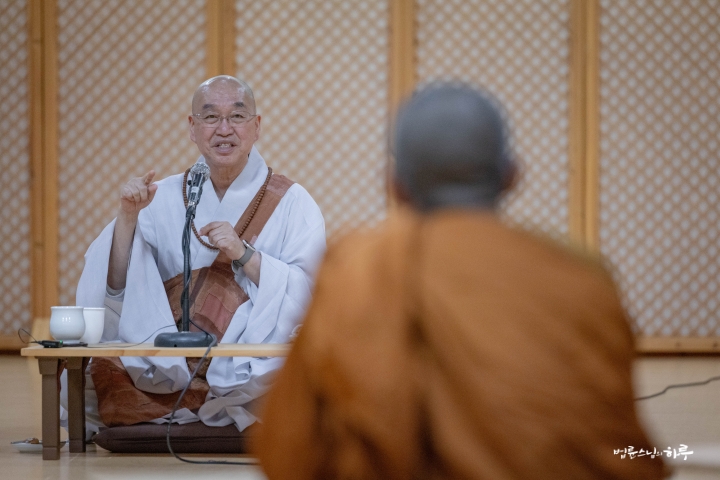
Only after confirming this does JTS help the residents. When several projects succeed, word spreads to others, and trust gradually builds as they see the results. So there’s no special trick to gaining trust. It takes a lot of time.”
“When you fundraise, do you usually have a specific purpose? I’m curious if you inform people that you’re fundraising for a particular purpose.”
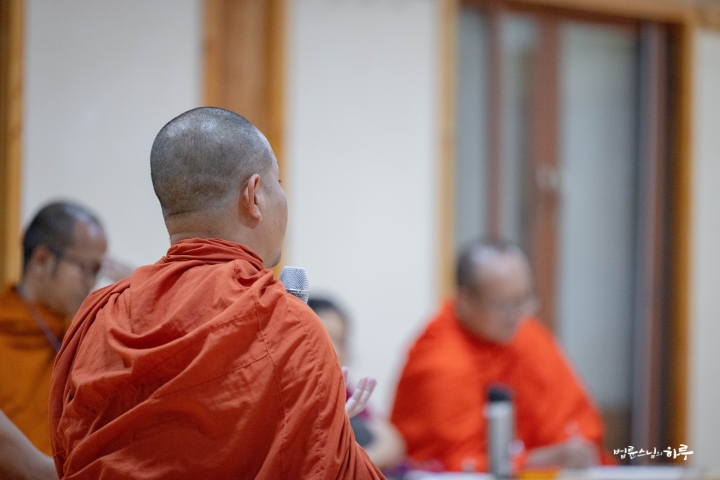
“The only time I’ve fundraised was during the campaign to help North Korean compatriots. At that time, many people were starving to death in North Korea, so we needed a lot of money for food aid to prevent that. Back then, I even went out on the streets to fundraise. I directly told people, ‘People are starving to death, so please donate money.’ But other than that, I haven’t asked people to donate money for any particular cause. However, whether it’s the Mindanao project or the Bhutan project, when we inform people of the results, they see them and make donations.”
“How do you inform people about the project results?”
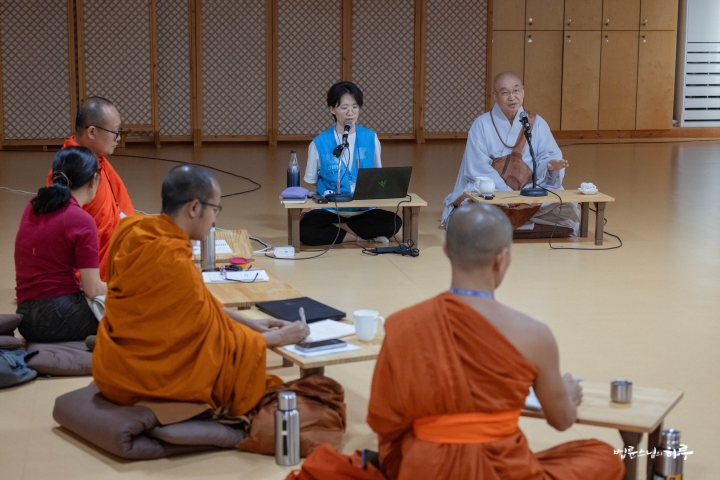
“Currently, there’s no special way to inform people separately. ‘A Day in the Life of Sunim’ is posted daily on the Jungto Society website, and Dharma Q&A lectures are uploaded to YouTube. Since we have these social media channels that share Sunim’s activities daily, people mainly learn about the projects through them and make donations. This is possible because we have a fixed readership.”
Next came questions about why and how the India pilgrimage is conducted annually, and about participation qualifications. Anchali, who went on the India pilgrimage last year, shared her experience.
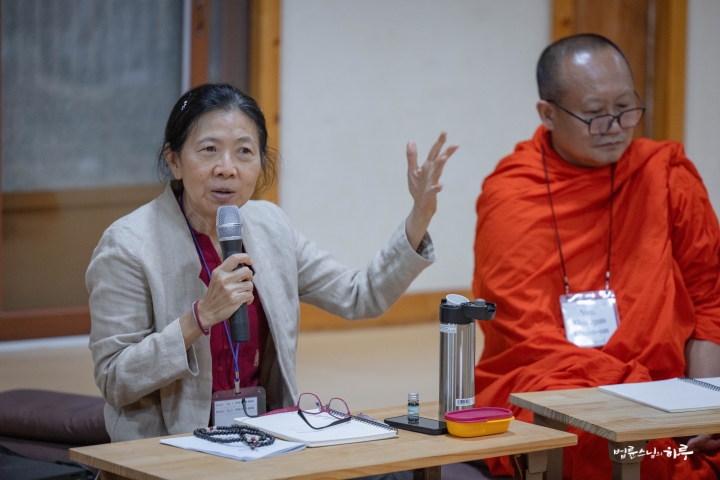
“I felt that the India pilgrimage guided by Venerable Pomnyun Sunim was deeply connected to the Buddha’s teachings. Of course, we couldn’t shower for ten days. We also walked for five hours. We carried sleeping bags, slept in pilgrim lodges, cooked our own rice with electric rice cookers – it was a very difficult journey. But it was an unforgettable experience. I highly recommend that you all go.”
Sunim said with a smile:
“She says that because she’s already been. When we were actually traveling, everyone was crying out about how hard it was.” (Laughter)

After a good laugh, they continued their conversation.
Venerable Sayadej from Laos asked a question about meditation.
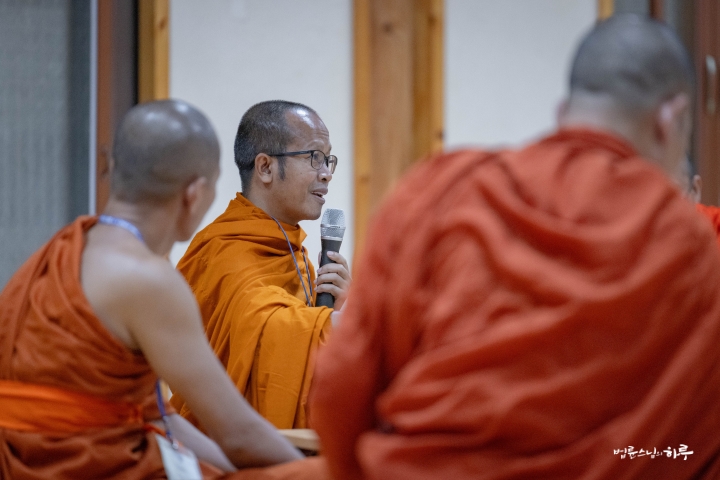
How Should We Understand the Teaching That We Don’t Need to Know Anything in Meditation?
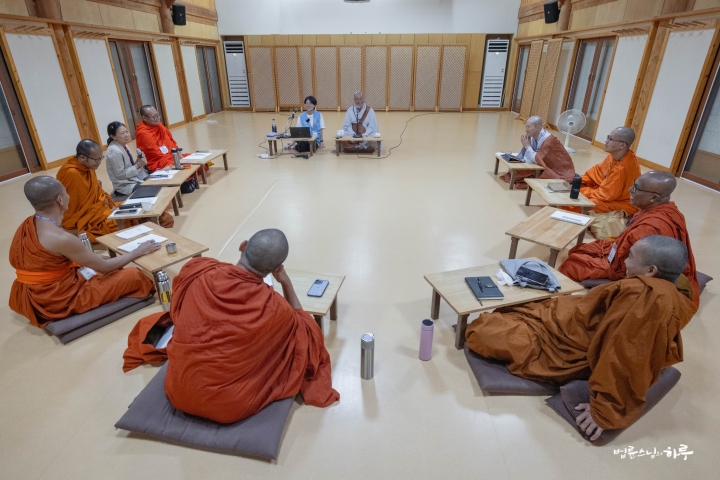
“The essence of saying to abandon what you’ve learned is not to meditate with thoughts. While we need a lot of knowledge to live our lives, thoughts become obstacles when we try to eliminate defilements and attain enlightenment. You can attain enlightenment and eliminate defilements without knowing anything. However, if you have no knowledge at all, you cannot do anything in the world. To do anything in the world, you need to know something.
The Buddha achieved nirvana through enlightenment, not through knowledge. Nirvana is reaching a state without suffering, and anyone can reach it regardless of how much or little knowledge they have. However, when the Buddha taught people for 45 years, he needed a lot of knowledge. Even if we reach the state of nirvana like the Buddha, we need various kinds of knowledge for teaching activities, and the more we know, the broader our teaching can be.
I can have conversations with scientists because I have scientific knowledge. I can converse with numerous experts because I have knowledge about their fields. Experts have knowledge but many defilements. I have knowledge but no defilements, which is why conversation is possible. Even if I had no defilements, if I had no knowledge, I couldn’t converse with them. This is because conversation happens through exchanging what we know. The Buddha, having been educated as a prince and knowing much about the world, was able to teach numerous kings and people after attaining enlightenment. So you shouldn’t misunderstand this to mean you don’t need to read the scriptures.
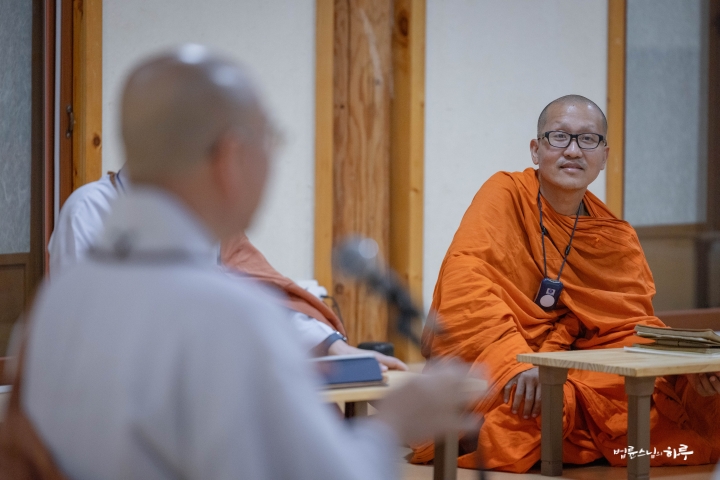
When meditating, you should rest your thoughts. However, thoughts arise continuously. This is natural. For example, if a thought about coffee arises, then a thought about a friend follows, and this moves on to the next thought. The initial thought about coffee arising is natural. However, if you follow that thought and let it lead to thoughts about a friend, it becomes delusion. At that point, you’ve lost awareness because your mind has already gone elsewhere. When you create stories like this, it becomes affliction. However, there’s no problem with countless thoughts arising and disappearing in themselves. Just as you meditate while letting outside sounds be, you simply need to maintain awareness without giving meaning to arising thoughts.
When meditating, most people sit and think many thoughts. That’s why they become tired. If there’s only awareness within comfort, there’s no reason to be tired. However, many people strain themselves to meditate, which is why they become very tired. That’s why after meditating for five days, one day of rest is needed. In fact, those five days of meditation should be rest. However, beginners often can’t rest well through meditation. It’s because they tense up trying to do well. The problem is trying to meditate well just as one tries to work well.
In Seon Buddhism, Seon masters are called ‘people with nothing to do.’ Since they have nothing to do, there’s nothing to move and nothing to think about. When we think, it means we have something to do. This means to let go of thoughts, not that you should be ignorant. Seon Buddhism also emphasizes traditional teachings like ‘don’t read sutras’ and ‘don’t establish words’ in the sense of letting go of thoughts. If this is misunderstood, one can become ignorant from not learning. That would be wrong.”
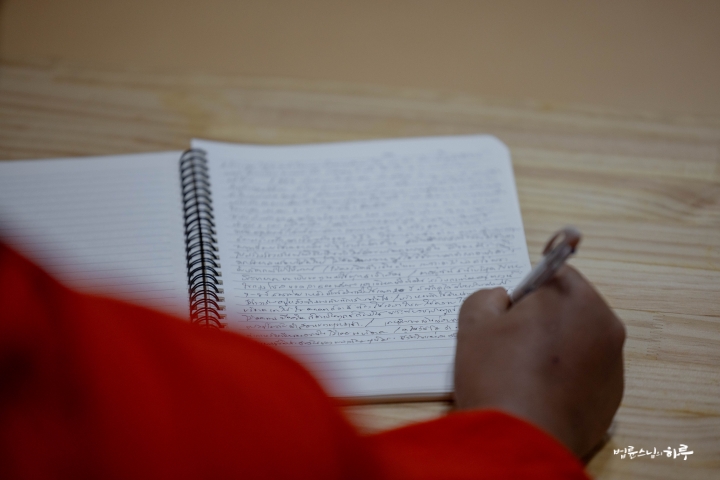
As the conversation deepened, it was past 9 PM.
“Let’s stop here for today. We’ll continue our dialogue tomorrow.”
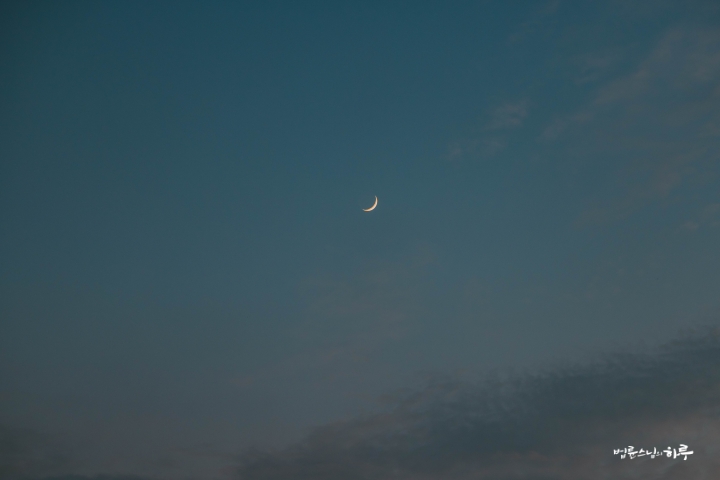
The INEB delegation visiting Jungto Society wrapped up the day with a brief mindful sharing session. Despite feeling tired, everyone earnestly shared their reflections from the day.
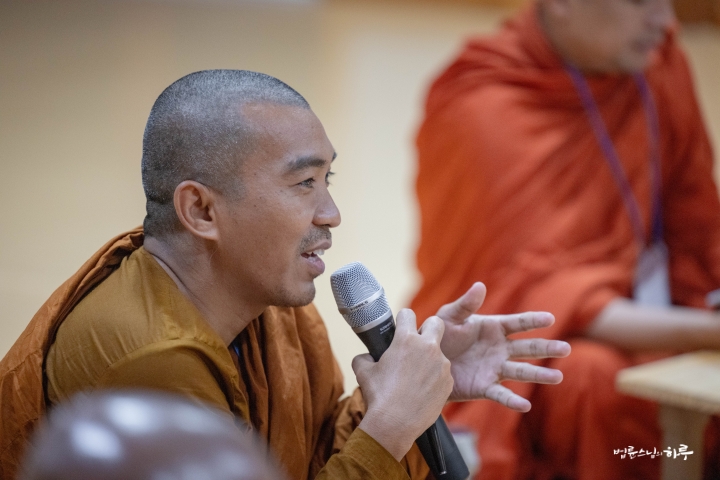
“During today’s dialogue, I kept asking myself questions. How can Venerable Pomnyun Sunim do so much work in various countries like Syria and Bhutan? Can I do it too? When I return to my home country, I’m determined to do my best.”
“When I return, I also want to improve the quality of teachers. I realized I need to understand children better. I’m also wondering if I should teach meditation to teachers. I’d like to apply the Happiness School program to our school.”
“I was deeply moved when Venerable Pomnyun Sunim explained the ‘Mu’ hwadu. Seon Buddhism came to me as a fresh shock.”
After completing the mindful sharing, everyone moved to Seonyudong Education and Training Center to retire for the night.
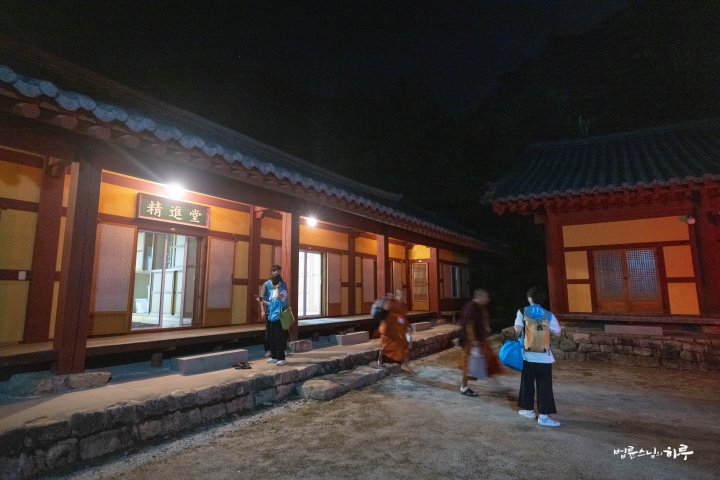
Tomorrow marks the fourth day of the INEB study tour. The day will begin with morning prayers at the Main Buddha Hall of Mungyeong Jungto Retreat Center, followed by an early morning live English Dharma Q&A for international participants. In the morning, there will be a presentation on Jungto Society’s organization and operations, followed by participants introducing their activities. The afternoon will feature focused discussions on the themes of ‘practice’ and ‘organizational management.’



